Human Resource Management Report: M&S HRM Strategies and Analysis
VerifiedAdded on 2022/12/26
|14
|4066
|59
Report
AI Summary
This report provides a comprehensive analysis of Human Resource Management (HRM) practices at Marks & Spencer. It begins by defining HRM and its core functions, including workforce planning, recruitment, selection, and employee development. The report examines the purpose of HRM, its functions within an organization, and its application in workforce planning and resourcing. It then explores different approaches to recruitment and selection, evaluating their strengths and weaknesses. The report also delves into the benefits of various HRM practices, such as providing job security and offering training and development opportunities, for both the employer and the employee. Furthermore, it analyzes the significance of employee relations in influencing HRM decision-making and identifies key elements of employment legislation and its impact. The report concludes by illustrating the application of HRM practices through specific examples within the context of Marks & Spencer, providing a detailed overview of the company's HRM strategies and their effectiveness.
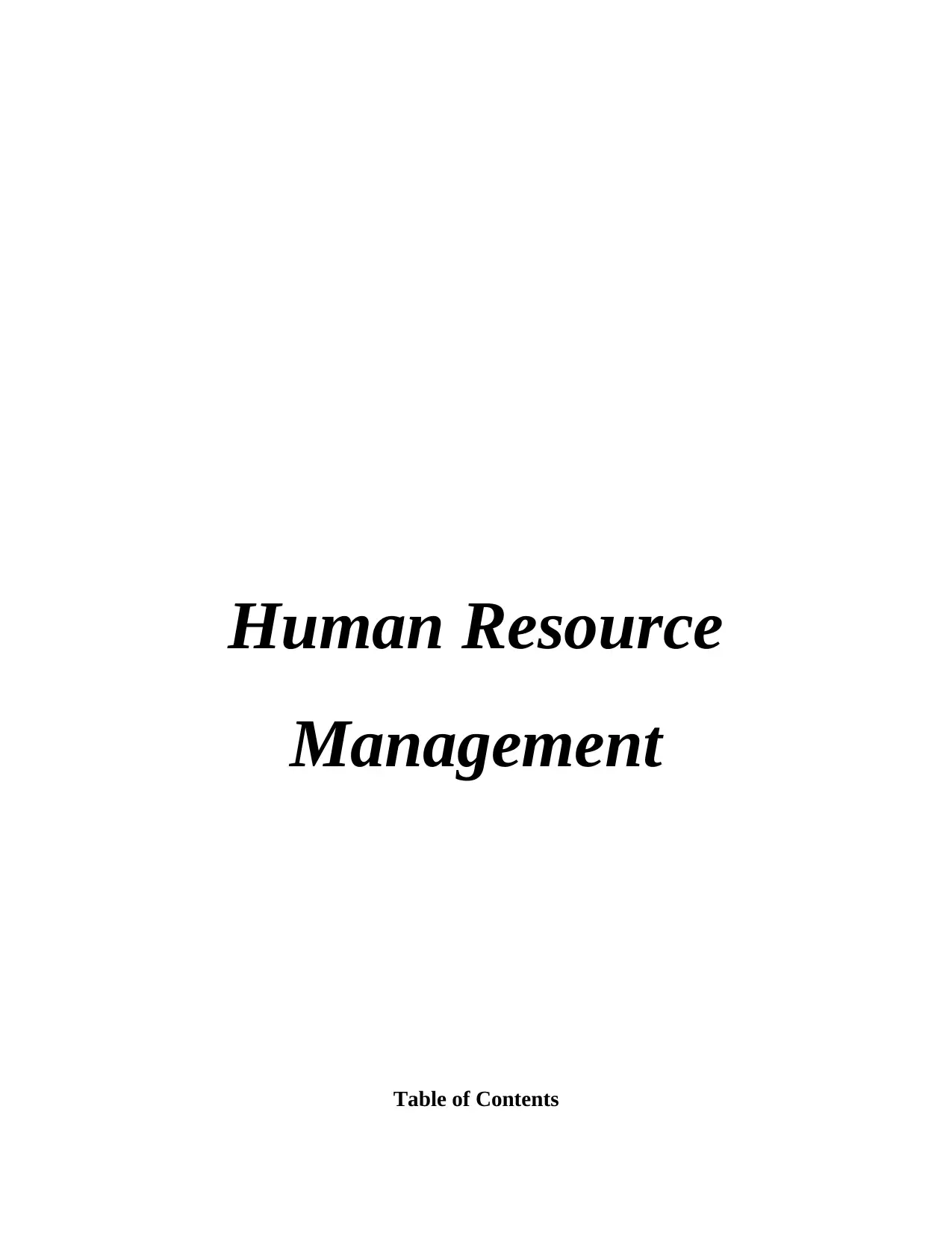
Human Resource
Management
Table of Contents
Management
Table of Contents
Paraphrase This Document
Need a fresh take? Get an instant paraphrase of this document with our AI Paraphraser
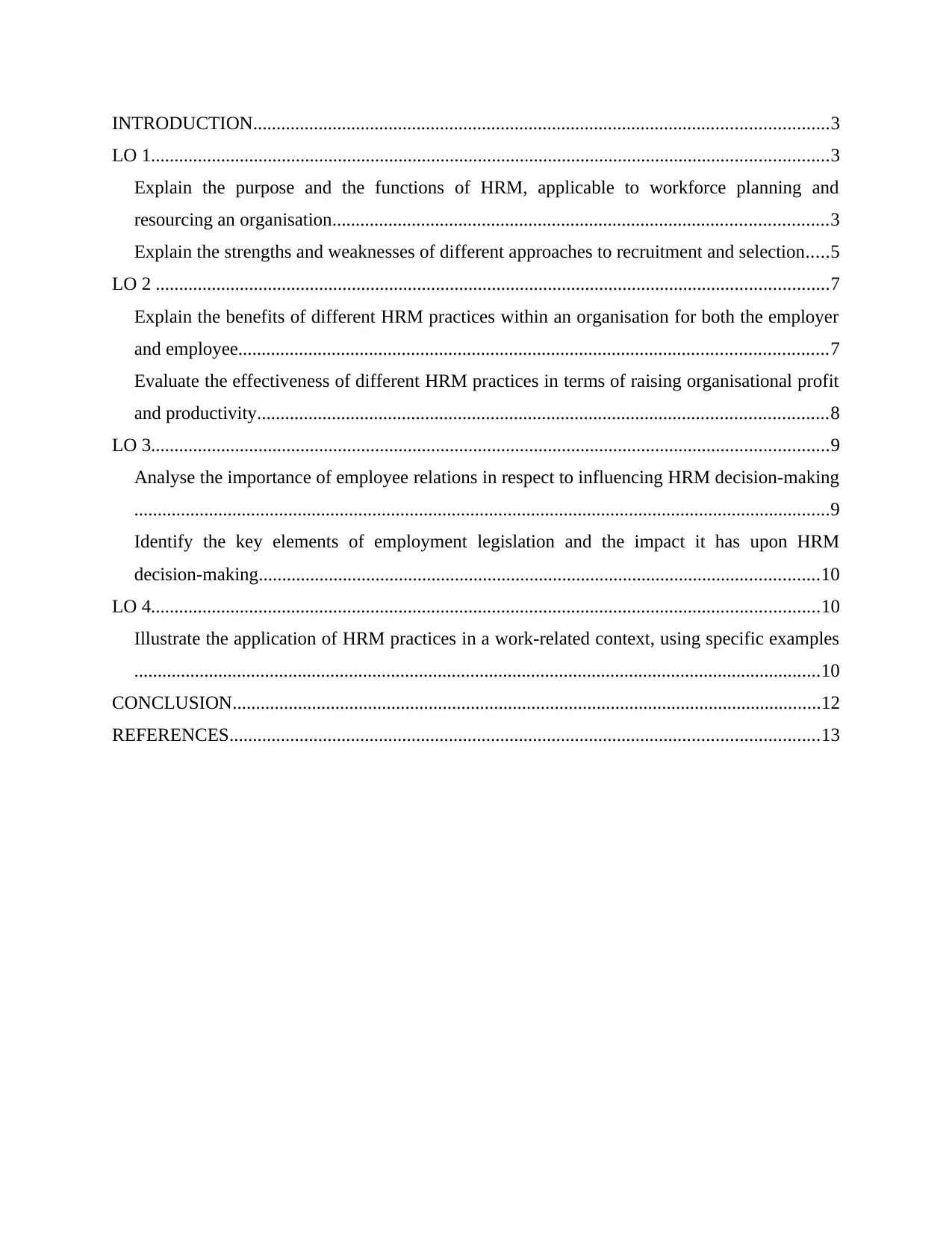
INTRODUCTION...........................................................................................................................3
LO 1.................................................................................................................................................3
Explain the purpose and the functions of HRM, applicable to workforce planning and
resourcing an organisation..........................................................................................................3
Explain the strengths and weaknesses of different approaches to recruitment and selection.....5
LO 2 ................................................................................................................................................7
Explain the benefits of different HRM practices within an organisation for both the employer
and employee..............................................................................................................................7
Evaluate the effectiveness of different HRM practices in terms of raising organisational profit
and productivity..........................................................................................................................8
LO 3.................................................................................................................................................9
Analyse the importance of employee relations in respect to influencing HRM decision-making
.....................................................................................................................................................9
Identify the key elements of employment legislation and the impact it has upon HRM
decision-making........................................................................................................................10
LO 4...............................................................................................................................................10
Illustrate the application of HRM practices in a work-related context, using specific examples
...................................................................................................................................................10
CONCLUSION..............................................................................................................................12
REFERENCES..............................................................................................................................13
LO 1.................................................................................................................................................3
Explain the purpose and the functions of HRM, applicable to workforce planning and
resourcing an organisation..........................................................................................................3
Explain the strengths and weaknesses of different approaches to recruitment and selection.....5
LO 2 ................................................................................................................................................7
Explain the benefits of different HRM practices within an organisation for both the employer
and employee..............................................................................................................................7
Evaluate the effectiveness of different HRM practices in terms of raising organisational profit
and productivity..........................................................................................................................8
LO 3.................................................................................................................................................9
Analyse the importance of employee relations in respect to influencing HRM decision-making
.....................................................................................................................................................9
Identify the key elements of employment legislation and the impact it has upon HRM
decision-making........................................................................................................................10
LO 4...............................................................................................................................................10
Illustrate the application of HRM practices in a work-related context, using specific examples
...................................................................................................................................................10
CONCLUSION..............................................................................................................................12
REFERENCES..............................................................................................................................13
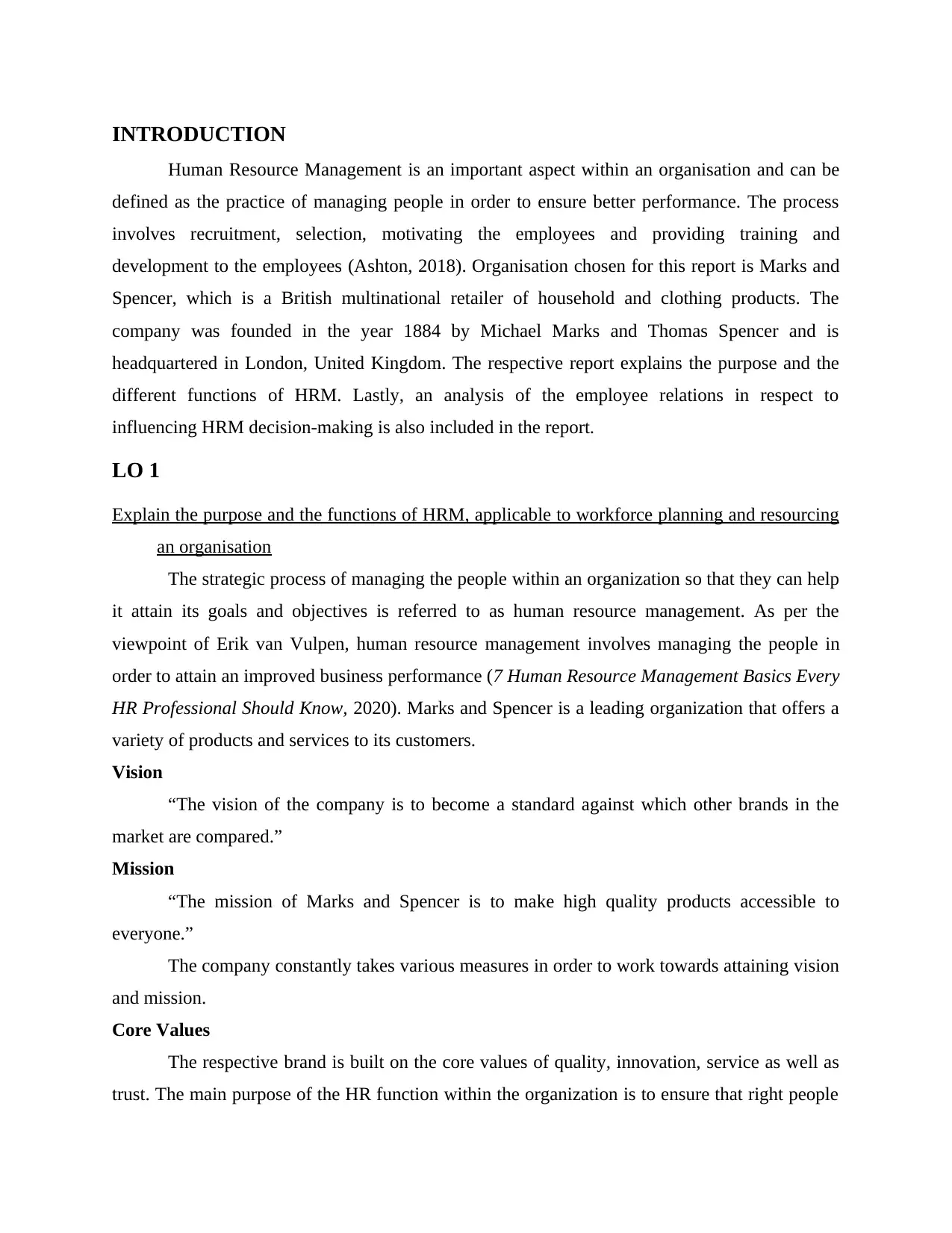
INTRODUCTION
Human Resource Management is an important aspect within an organisation and can be
defined as the practice of managing people in order to ensure better performance. The process
involves recruitment, selection, motivating the employees and providing training and
development to the employees (Ashton, 2018). Organisation chosen for this report is Marks and
Spencer, which is a British multinational retailer of household and clothing products. The
company was founded in the year 1884 by Michael Marks and Thomas Spencer and is
headquartered in London, United Kingdom. The respective report explains the purpose and the
different functions of HRM. Lastly, an analysis of the employee relations in respect to
influencing HRM decision-making is also included in the report.
LO 1
Explain the purpose and the functions of HRM, applicable to workforce planning and resourcing
an organisation
The strategic process of managing the people within an organization so that they can help
it attain its goals and objectives is referred to as human resource management. As per the
viewpoint of Erik van Vulpen, human resource management involves managing the people in
order to attain an improved business performance (7 Human Resource Management Basics Every
HR Professional Should Know, 2020). Marks and Spencer is a leading organization that offers a
variety of products and services to its customers.
Vision
“The vision of the company is to become a standard against which other brands in the
market are compared.”
Mission
“The mission of Marks and Spencer is to make high quality products accessible to
everyone.”
The company constantly takes various measures in order to work towards attaining vision
and mission.
Core Values
The respective brand is built on the core values of quality, innovation, service as well as
trust. The main purpose of the HR function within the organization is to ensure that right people
Human Resource Management is an important aspect within an organisation and can be
defined as the practice of managing people in order to ensure better performance. The process
involves recruitment, selection, motivating the employees and providing training and
development to the employees (Ashton, 2018). Organisation chosen for this report is Marks and
Spencer, which is a British multinational retailer of household and clothing products. The
company was founded in the year 1884 by Michael Marks and Thomas Spencer and is
headquartered in London, United Kingdom. The respective report explains the purpose and the
different functions of HRM. Lastly, an analysis of the employee relations in respect to
influencing HRM decision-making is also included in the report.
LO 1
Explain the purpose and the functions of HRM, applicable to workforce planning and resourcing
an organisation
The strategic process of managing the people within an organization so that they can help
it attain its goals and objectives is referred to as human resource management. As per the
viewpoint of Erik van Vulpen, human resource management involves managing the people in
order to attain an improved business performance (7 Human Resource Management Basics Every
HR Professional Should Know, 2020). Marks and Spencer is a leading organization that offers a
variety of products and services to its customers.
Vision
“The vision of the company is to become a standard against which other brands in the
market are compared.”
Mission
“The mission of Marks and Spencer is to make high quality products accessible to
everyone.”
The company constantly takes various measures in order to work towards attaining vision
and mission.
Core Values
The respective brand is built on the core values of quality, innovation, service as well as
trust. The main purpose of the HR function within the organization is to ensure that right people
⊘ This is a preview!⊘
Do you want full access?
Subscribe today to unlock all pages.

Trusted by 1+ million students worldwide
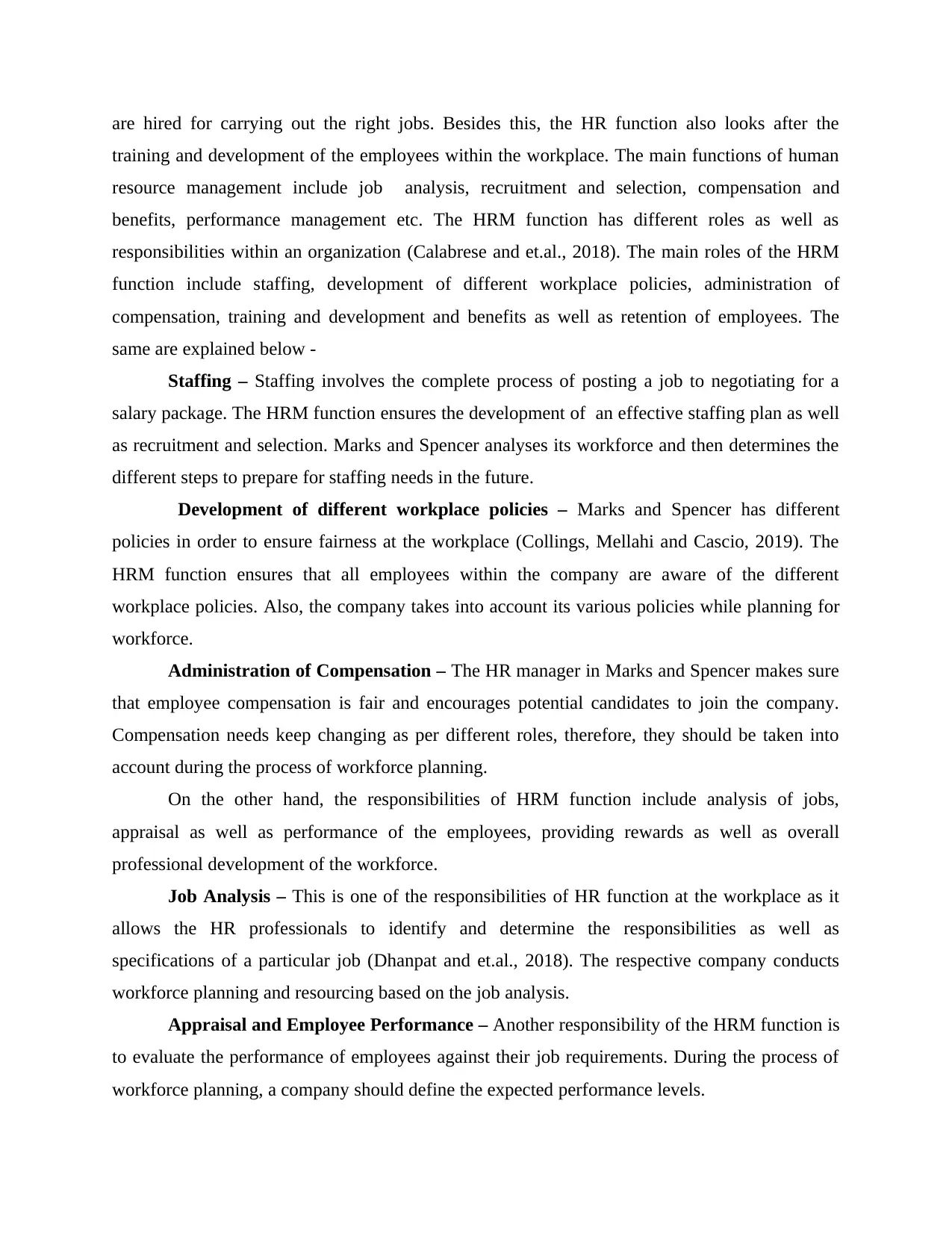
are hired for carrying out the right jobs. Besides this, the HR function also looks after the
training and development of the employees within the workplace. The main functions of human
resource management include job analysis, recruitment and selection, compensation and
benefits, performance management etc. The HRM function has different roles as well as
responsibilities within an organization (Calabrese and et.al., 2018). The main roles of the HRM
function include staffing, development of different workplace policies, administration of
compensation, training and development and benefits as well as retention of employees. The
same are explained below -
Staffing – Staffing involves the complete process of posting a job to negotiating for a
salary package. The HRM function ensures the development of an effective staffing plan as well
as recruitment and selection. Marks and Spencer analyses its workforce and then determines the
different steps to prepare for staffing needs in the future.
Development of different workplace policies – Marks and Spencer has different
policies in order to ensure fairness at the workplace (Collings, Mellahi and Cascio, 2019). The
HRM function ensures that all employees within the company are aware of the different
workplace policies. Also, the company takes into account its various policies while planning for
workforce.
Administration of Compensation – The HR manager in Marks and Spencer makes sure
that employee compensation is fair and encourages potential candidates to join the company.
Compensation needs keep changing as per different roles, therefore, they should be taken into
account during the process of workforce planning.
On the other hand, the responsibilities of HRM function include analysis of jobs,
appraisal as well as performance of the employees, providing rewards as well as overall
professional development of the workforce.
Job Analysis – This is one of the responsibilities of HR function at the workplace as it
allows the HR professionals to identify and determine the responsibilities as well as
specifications of a particular job (Dhanpat and et.al., 2018). The respective company conducts
workforce planning and resourcing based on the job analysis.
Appraisal and Employee Performance – Another responsibility of the HRM function is
to evaluate the performance of employees against their job requirements. During the process of
workforce planning, a company should define the expected performance levels.
training and development of the employees within the workplace. The main functions of human
resource management include job analysis, recruitment and selection, compensation and
benefits, performance management etc. The HRM function has different roles as well as
responsibilities within an organization (Calabrese and et.al., 2018). The main roles of the HRM
function include staffing, development of different workplace policies, administration of
compensation, training and development and benefits as well as retention of employees. The
same are explained below -
Staffing – Staffing involves the complete process of posting a job to negotiating for a
salary package. The HRM function ensures the development of an effective staffing plan as well
as recruitment and selection. Marks and Spencer analyses its workforce and then determines the
different steps to prepare for staffing needs in the future.
Development of different workplace policies – Marks and Spencer has different
policies in order to ensure fairness at the workplace (Collings, Mellahi and Cascio, 2019). The
HRM function ensures that all employees within the company are aware of the different
workplace policies. Also, the company takes into account its various policies while planning for
workforce.
Administration of Compensation – The HR manager in Marks and Spencer makes sure
that employee compensation is fair and encourages potential candidates to join the company.
Compensation needs keep changing as per different roles, therefore, they should be taken into
account during the process of workforce planning.
On the other hand, the responsibilities of HRM function include analysis of jobs,
appraisal as well as performance of the employees, providing rewards as well as overall
professional development of the workforce.
Job Analysis – This is one of the responsibilities of HR function at the workplace as it
allows the HR professionals to identify and determine the responsibilities as well as
specifications of a particular job (Dhanpat and et.al., 2018). The respective company conducts
workforce planning and resourcing based on the job analysis.
Appraisal and Employee Performance – Another responsibility of the HRM function is
to evaluate the performance of employees against their job requirements. During the process of
workforce planning, a company should define the expected performance levels.
Paraphrase This Document
Need a fresh take? Get an instant paraphrase of this document with our AI Paraphraser
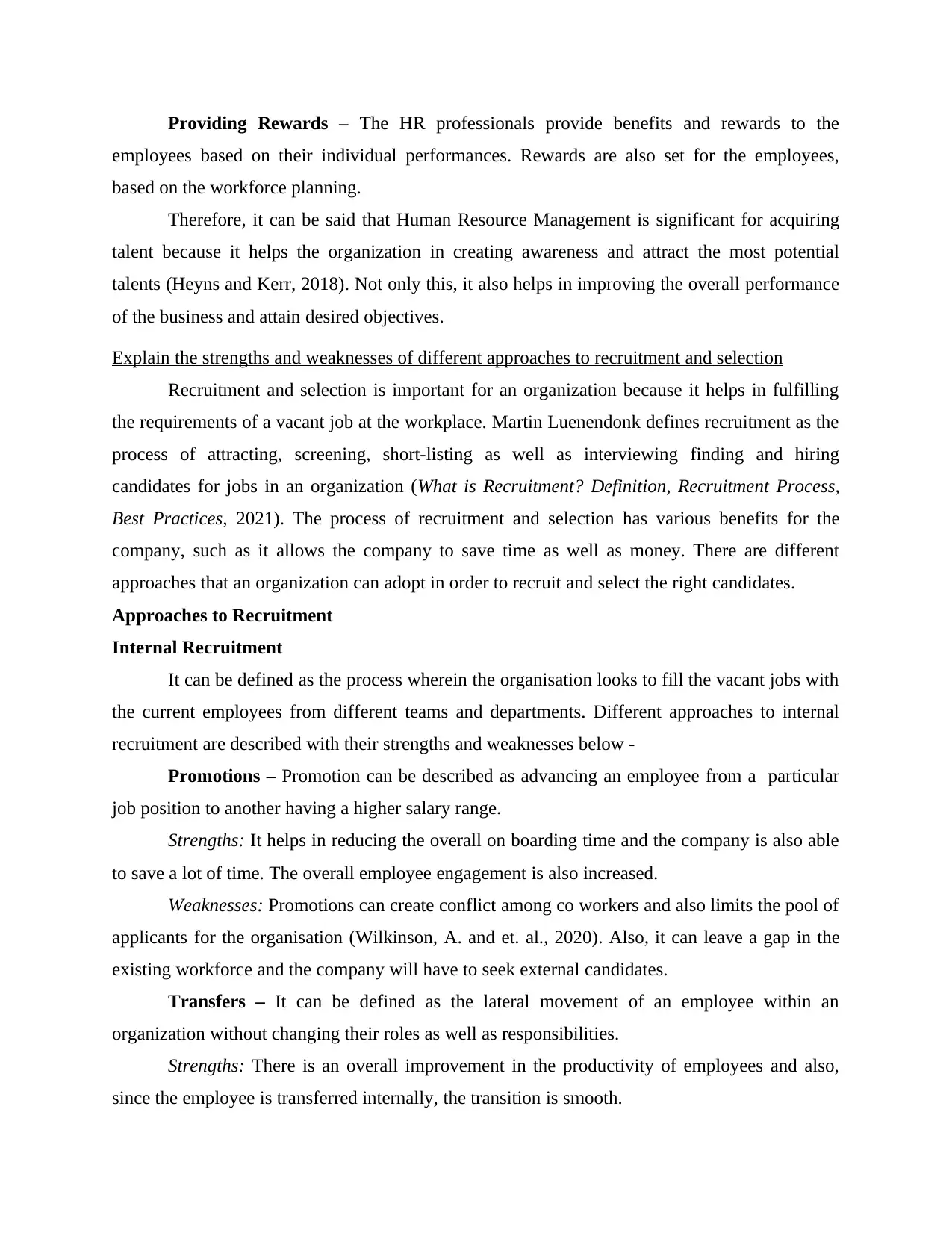
Providing Rewards – The HR professionals provide benefits and rewards to the
employees based on their individual performances. Rewards are also set for the employees,
based on the workforce planning.
Therefore, it can be said that Human Resource Management is significant for acquiring
talent because it helps the organization in creating awareness and attract the most potential
talents (Heyns and Kerr, 2018). Not only this, it also helps in improving the overall performance
of the business and attain desired objectives.
Explain the strengths and weaknesses of different approaches to recruitment and selection
Recruitment and selection is important for an organization because it helps in fulfilling
the requirements of a vacant job at the workplace. Martin Luenendonk defines recruitment as the
process of attracting, screening, short-listing as well as interviewing finding and hiring
candidates for jobs in an organization (What is Recruitment? Definition, Recruitment Process,
Best Practices, 2021). The process of recruitment and selection has various benefits for the
company, such as it allows the company to save time as well as money. There are different
approaches that an organization can adopt in order to recruit and select the right candidates.
Approaches to Recruitment
Internal Recruitment
It can be defined as the process wherein the organisation looks to fill the vacant jobs with
the current employees from different teams and departments. Different approaches to internal
recruitment are described with their strengths and weaknesses below -
Promotions – Promotion can be described as advancing an employee from a particular
job position to another having a higher salary range.
Strengths: It helps in reducing the overall on boarding time and the company is also able
to save a lot of time. The overall employee engagement is also increased.
Weaknesses: Promotions can create conflict among co workers and also limits the pool of
applicants for the organisation (Wilkinson, A. and et. al., 2020). Also, it can leave a gap in the
existing workforce and the company will have to seek external candidates.
Transfers – It can be defined as the lateral movement of an employee within an
organization without changing their roles as well as responsibilities.
Strengths: There is an overall improvement in the productivity of employees and also,
since the employee is transferred internally, the transition is smooth.
employees based on their individual performances. Rewards are also set for the employees,
based on the workforce planning.
Therefore, it can be said that Human Resource Management is significant for acquiring
talent because it helps the organization in creating awareness and attract the most potential
talents (Heyns and Kerr, 2018). Not only this, it also helps in improving the overall performance
of the business and attain desired objectives.
Explain the strengths and weaknesses of different approaches to recruitment and selection
Recruitment and selection is important for an organization because it helps in fulfilling
the requirements of a vacant job at the workplace. Martin Luenendonk defines recruitment as the
process of attracting, screening, short-listing as well as interviewing finding and hiring
candidates for jobs in an organization (What is Recruitment? Definition, Recruitment Process,
Best Practices, 2021). The process of recruitment and selection has various benefits for the
company, such as it allows the company to save time as well as money. There are different
approaches that an organization can adopt in order to recruit and select the right candidates.
Approaches to Recruitment
Internal Recruitment
It can be defined as the process wherein the organisation looks to fill the vacant jobs with
the current employees from different teams and departments. Different approaches to internal
recruitment are described with their strengths and weaknesses below -
Promotions – Promotion can be described as advancing an employee from a particular
job position to another having a higher salary range.
Strengths: It helps in reducing the overall on boarding time and the company is also able
to save a lot of time. The overall employee engagement is also increased.
Weaknesses: Promotions can create conflict among co workers and also limits the pool of
applicants for the organisation (Wilkinson, A. and et. al., 2020). Also, it can leave a gap in the
existing workforce and the company will have to seek external candidates.
Transfers – It can be defined as the lateral movement of an employee within an
organization without changing their roles as well as responsibilities.
Strengths: There is an overall improvement in the productivity of employees and also,
since the employee is transferred internally, the transition is smooth.
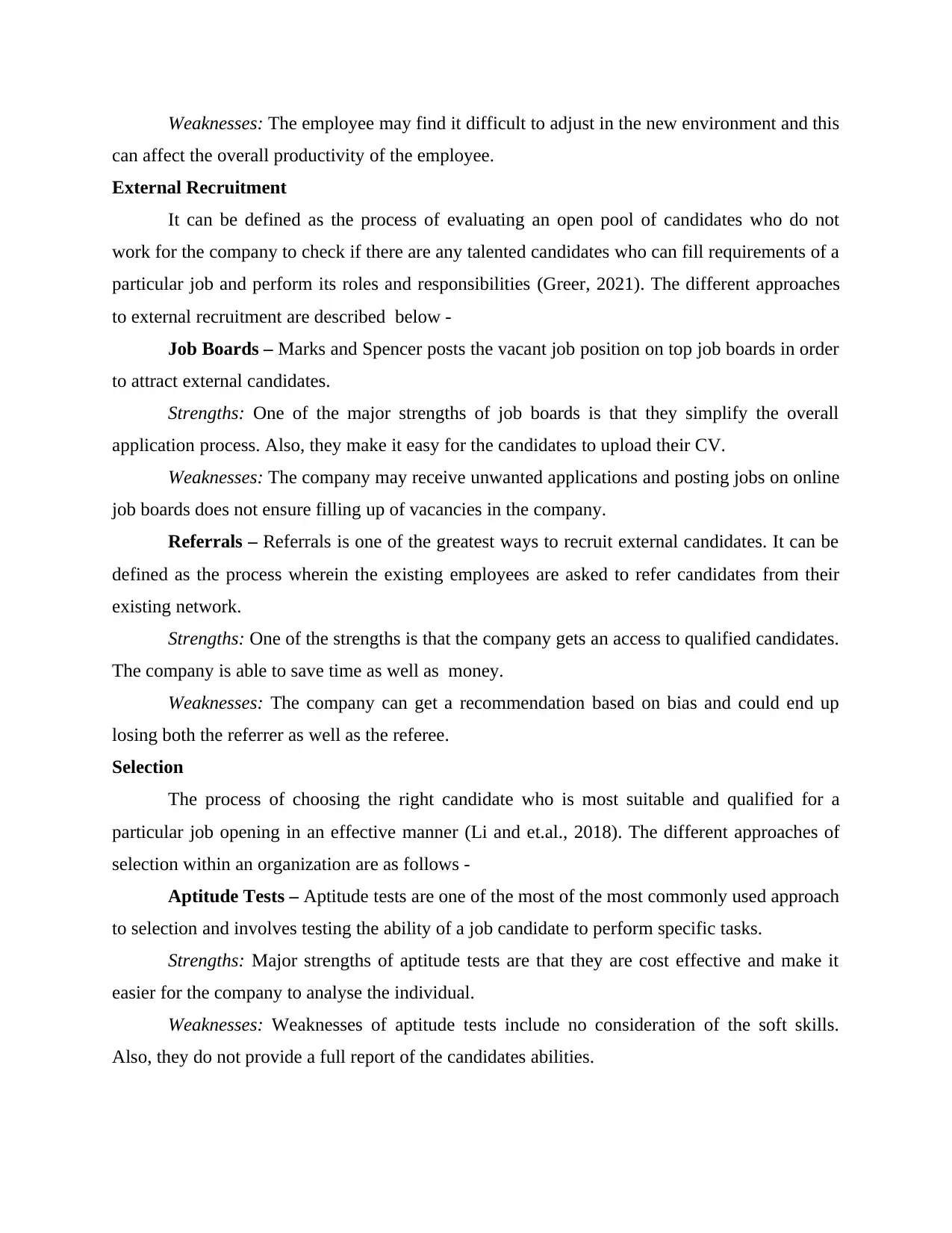
Weaknesses: The employee may find it difficult to adjust in the new environment and this
can affect the overall productivity of the employee.
External Recruitment
It can be defined as the process of evaluating an open pool of candidates who do not
work for the company to check if there are any talented candidates who can fill requirements of a
particular job and perform its roles and responsibilities (Greer, 2021). The different approaches
to external recruitment are described below -
Job Boards – Marks and Spencer posts the vacant job position on top job boards in order
to attract external candidates.
Strengths: One of the major strengths of job boards is that they simplify the overall
application process. Also, they make it easy for the candidates to upload their CV.
Weaknesses: The company may receive unwanted applications and posting jobs on online
job boards does not ensure filling up of vacancies in the company.
Referrals – Referrals is one of the greatest ways to recruit external candidates. It can be
defined as the process wherein the existing employees are asked to refer candidates from their
existing network.
Strengths: One of the strengths is that the company gets an access to qualified candidates.
The company is able to save time as well as money.
Weaknesses: The company can get a recommendation based on bias and could end up
losing both the referrer as well as the referee.
Selection
The process of choosing the right candidate who is most suitable and qualified for a
particular job opening in an effective manner (Li and et.al., 2018). The different approaches of
selection within an organization are as follows -
Aptitude Tests – Aptitude tests are one of the most of the most commonly used approach
to selection and involves testing the ability of a job candidate to perform specific tasks.
Strengths: Major strengths of aptitude tests are that they are cost effective and make it
easier for the company to analyse the individual.
Weaknesses: Weaknesses of aptitude tests include no consideration of the soft skills.
Also, they do not provide a full report of the candidates abilities.
can affect the overall productivity of the employee.
External Recruitment
It can be defined as the process of evaluating an open pool of candidates who do not
work for the company to check if there are any talented candidates who can fill requirements of a
particular job and perform its roles and responsibilities (Greer, 2021). The different approaches
to external recruitment are described below -
Job Boards – Marks and Spencer posts the vacant job position on top job boards in order
to attract external candidates.
Strengths: One of the major strengths of job boards is that they simplify the overall
application process. Also, they make it easy for the candidates to upload their CV.
Weaknesses: The company may receive unwanted applications and posting jobs on online
job boards does not ensure filling up of vacancies in the company.
Referrals – Referrals is one of the greatest ways to recruit external candidates. It can be
defined as the process wherein the existing employees are asked to refer candidates from their
existing network.
Strengths: One of the strengths is that the company gets an access to qualified candidates.
The company is able to save time as well as money.
Weaknesses: The company can get a recommendation based on bias and could end up
losing both the referrer as well as the referee.
Selection
The process of choosing the right candidate who is most suitable and qualified for a
particular job opening in an effective manner (Li and et.al., 2018). The different approaches of
selection within an organization are as follows -
Aptitude Tests – Aptitude tests are one of the most of the most commonly used approach
to selection and involves testing the ability of a job candidate to perform specific tasks.
Strengths: Major strengths of aptitude tests are that they are cost effective and make it
easier for the company to analyse the individual.
Weaknesses: Weaknesses of aptitude tests include no consideration of the soft skills.
Also, they do not provide a full report of the candidates abilities.
⊘ This is a preview!⊘
Do you want full access?
Subscribe today to unlock all pages.

Trusted by 1+ million students worldwide
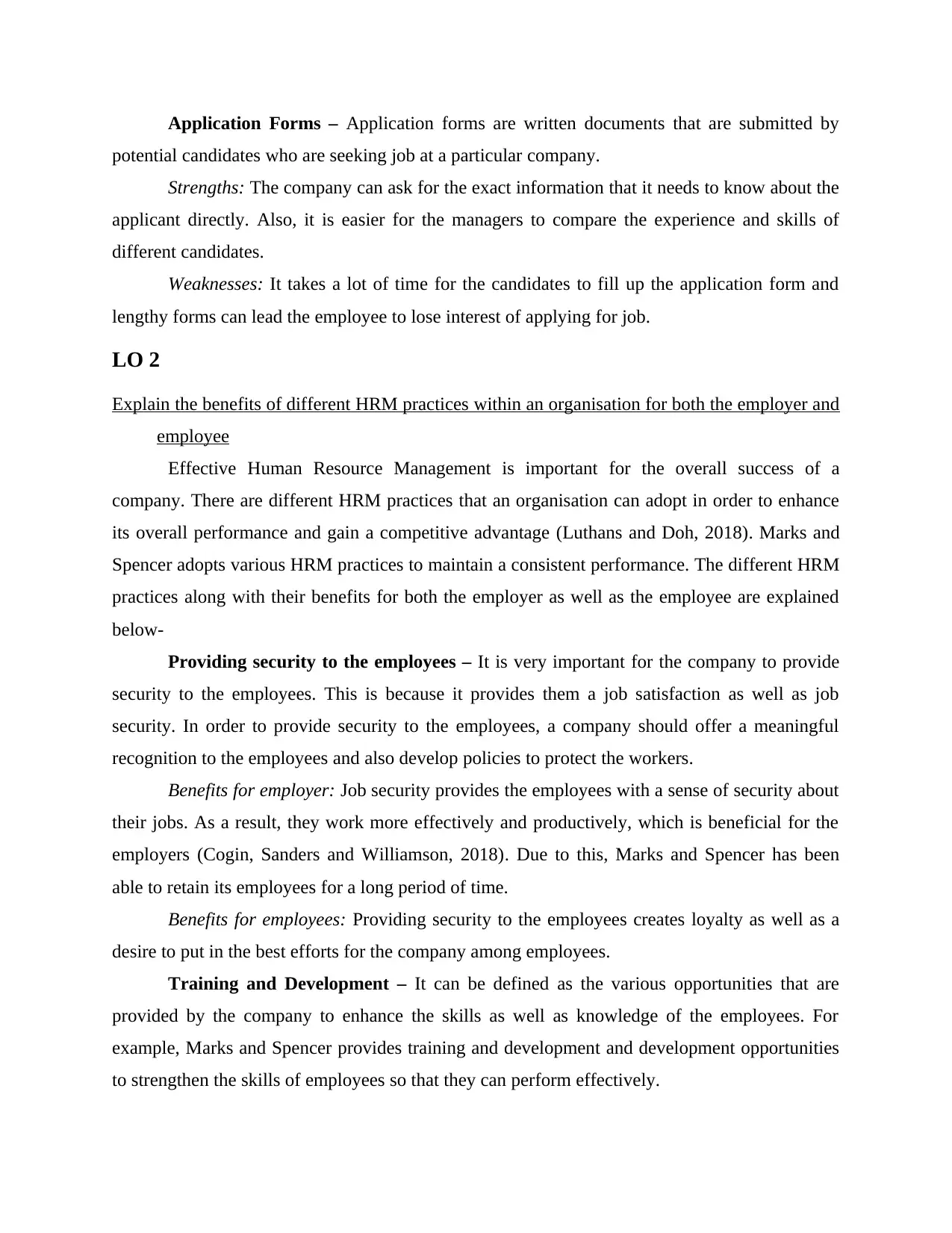
Application Forms – Application forms are written documents that are submitted by
potential candidates who are seeking job at a particular company.
Strengths: The company can ask for the exact information that it needs to know about the
applicant directly. Also, it is easier for the managers to compare the experience and skills of
different candidates.
Weaknesses: It takes a lot of time for the candidates to fill up the application form and
lengthy forms can lead the employee to lose interest of applying for job.
LO 2
Explain the benefits of different HRM practices within an organisation for both the employer and
employee
Effective Human Resource Management is important for the overall success of a
company. There are different HRM practices that an organisation can adopt in order to enhance
its overall performance and gain a competitive advantage (Luthans and Doh, 2018). Marks and
Spencer adopts various HRM practices to maintain a consistent performance. The different HRM
practices along with their benefits for both the employer as well as the employee are explained
below-
Providing security to the employees – It is very important for the company to provide
security to the employees. This is because it provides them a job satisfaction as well as job
security. In order to provide security to the employees, a company should offer a meaningful
recognition to the employees and also develop policies to protect the workers.
Benefits for employer: Job security provides the employees with a sense of security about
their jobs. As a result, they work more effectively and productively, which is beneficial for the
employers (Cogin, Sanders and Williamson, 2018). Due to this, Marks and Spencer has been
able to retain its employees for a long period of time.
Benefits for employees: Providing security to the employees creates loyalty as well as a
desire to put in the best efforts for the company among employees.
Training and Development – It can be defined as the various opportunities that are
provided by the company to enhance the skills as well as knowledge of the employees. For
example, Marks and Spencer provides training and development and development opportunities
to strengthen the skills of employees so that they can perform effectively.
potential candidates who are seeking job at a particular company.
Strengths: The company can ask for the exact information that it needs to know about the
applicant directly. Also, it is easier for the managers to compare the experience and skills of
different candidates.
Weaknesses: It takes a lot of time for the candidates to fill up the application form and
lengthy forms can lead the employee to lose interest of applying for job.
LO 2
Explain the benefits of different HRM practices within an organisation for both the employer and
employee
Effective Human Resource Management is important for the overall success of a
company. There are different HRM practices that an organisation can adopt in order to enhance
its overall performance and gain a competitive advantage (Luthans and Doh, 2018). Marks and
Spencer adopts various HRM practices to maintain a consistent performance. The different HRM
practices along with their benefits for both the employer as well as the employee are explained
below-
Providing security to the employees – It is very important for the company to provide
security to the employees. This is because it provides them a job satisfaction as well as job
security. In order to provide security to the employees, a company should offer a meaningful
recognition to the employees and also develop policies to protect the workers.
Benefits for employer: Job security provides the employees with a sense of security about
their jobs. As a result, they work more effectively and productively, which is beneficial for the
employers (Cogin, Sanders and Williamson, 2018). Due to this, Marks and Spencer has been
able to retain its employees for a long period of time.
Benefits for employees: Providing security to the employees creates loyalty as well as a
desire to put in the best efforts for the company among employees.
Training and Development – It can be defined as the various opportunities that are
provided by the company to enhance the skills as well as knowledge of the employees. For
example, Marks and Spencer provides training and development and development opportunities
to strengthen the skills of employees so that they can perform effectively.
Paraphrase This Document
Need a fresh take? Get an instant paraphrase of this document with our AI Paraphraser
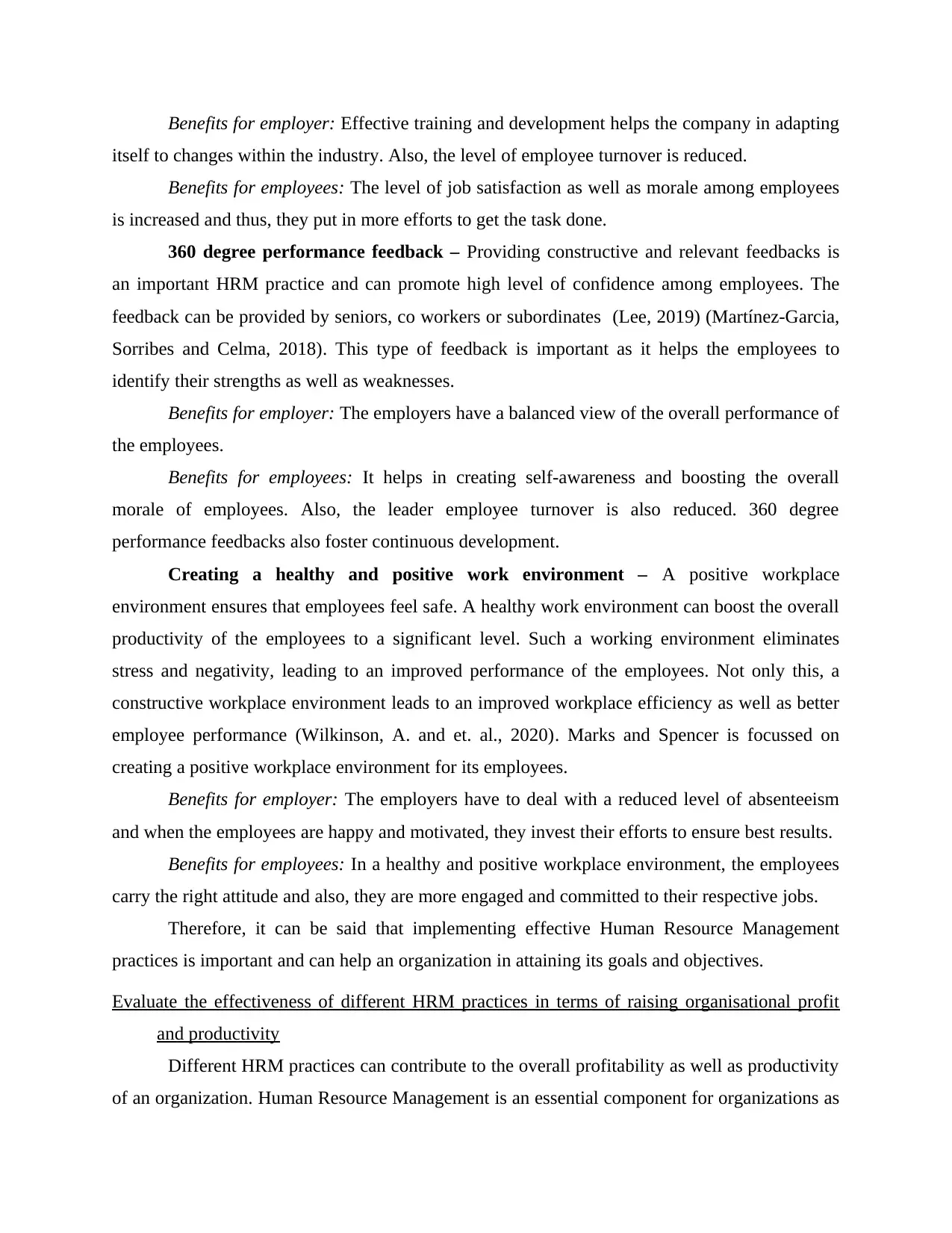
Benefits for employer: Effective training and development helps the company in adapting
itself to changes within the industry. Also, the level of employee turnover is reduced.
Benefits for employees: The level of job satisfaction as well as morale among employees
is increased and thus, they put in more efforts to get the task done.
360 degree performance feedback – Providing constructive and relevant feedbacks is
an important HRM practice and can promote high level of confidence among employees. The
feedback can be provided by seniors, co workers or subordinates (Lee, 2019) (Martínez‐Garcia,
Sorribes and Celma, 2018). This type of feedback is important as it helps the employees to
identify their strengths as well as weaknesses.
Benefits for employer: The employers have a balanced view of the overall performance of
the employees.
Benefits for employees: It helps in creating self-awareness and boosting the overall
morale of employees. Also, the leader employee turnover is also reduced. 360 degree
performance feedbacks also foster continuous development.
Creating a healthy and positive work environment – A positive workplace
environment ensures that employees feel safe. A healthy work environment can boost the overall
productivity of the employees to a significant level. Such a working environment eliminates
stress and negativity, leading to an improved performance of the employees. Not only this, a
constructive workplace environment leads to an improved workplace efficiency as well as better
employee performance (Wilkinson, A. and et. al., 2020). Marks and Spencer is focussed on
creating a positive workplace environment for its employees.
Benefits for employer: The employers have to deal with a reduced level of absenteeism
and when the employees are happy and motivated, they invest their efforts to ensure best results.
Benefits for employees: In a healthy and positive workplace environment, the employees
carry the right attitude and also, they are more engaged and committed to their respective jobs.
Therefore, it can be said that implementing effective Human Resource Management
practices is important and can help an organization in attaining its goals and objectives.
Evaluate the effectiveness of different HRM practices in terms of raising organisational profit
and productivity
Different HRM practices can contribute to the overall profitability as well as productivity
of an organization. Human Resource Management is an essential component for organizations as
itself to changes within the industry. Also, the level of employee turnover is reduced.
Benefits for employees: The level of job satisfaction as well as morale among employees
is increased and thus, they put in more efforts to get the task done.
360 degree performance feedback – Providing constructive and relevant feedbacks is
an important HRM practice and can promote high level of confidence among employees. The
feedback can be provided by seniors, co workers or subordinates (Lee, 2019) (Martínez‐Garcia,
Sorribes and Celma, 2018). This type of feedback is important as it helps the employees to
identify their strengths as well as weaknesses.
Benefits for employer: The employers have a balanced view of the overall performance of
the employees.
Benefits for employees: It helps in creating self-awareness and boosting the overall
morale of employees. Also, the leader employee turnover is also reduced. 360 degree
performance feedbacks also foster continuous development.
Creating a healthy and positive work environment – A positive workplace
environment ensures that employees feel safe. A healthy work environment can boost the overall
productivity of the employees to a significant level. Such a working environment eliminates
stress and negativity, leading to an improved performance of the employees. Not only this, a
constructive workplace environment leads to an improved workplace efficiency as well as better
employee performance (Wilkinson, A. and et. al., 2020). Marks and Spencer is focussed on
creating a positive workplace environment for its employees.
Benefits for employer: The employers have to deal with a reduced level of absenteeism
and when the employees are happy and motivated, they invest their efforts to ensure best results.
Benefits for employees: In a healthy and positive workplace environment, the employees
carry the right attitude and also, they are more engaged and committed to their respective jobs.
Therefore, it can be said that implementing effective Human Resource Management
practices is important and can help an organization in attaining its goals and objectives.
Evaluate the effectiveness of different HRM practices in terms of raising organisational profit
and productivity
Different HRM practices can contribute to the overall profitability as well as productivity
of an organization. Human Resource Management is an essential component for organizations as
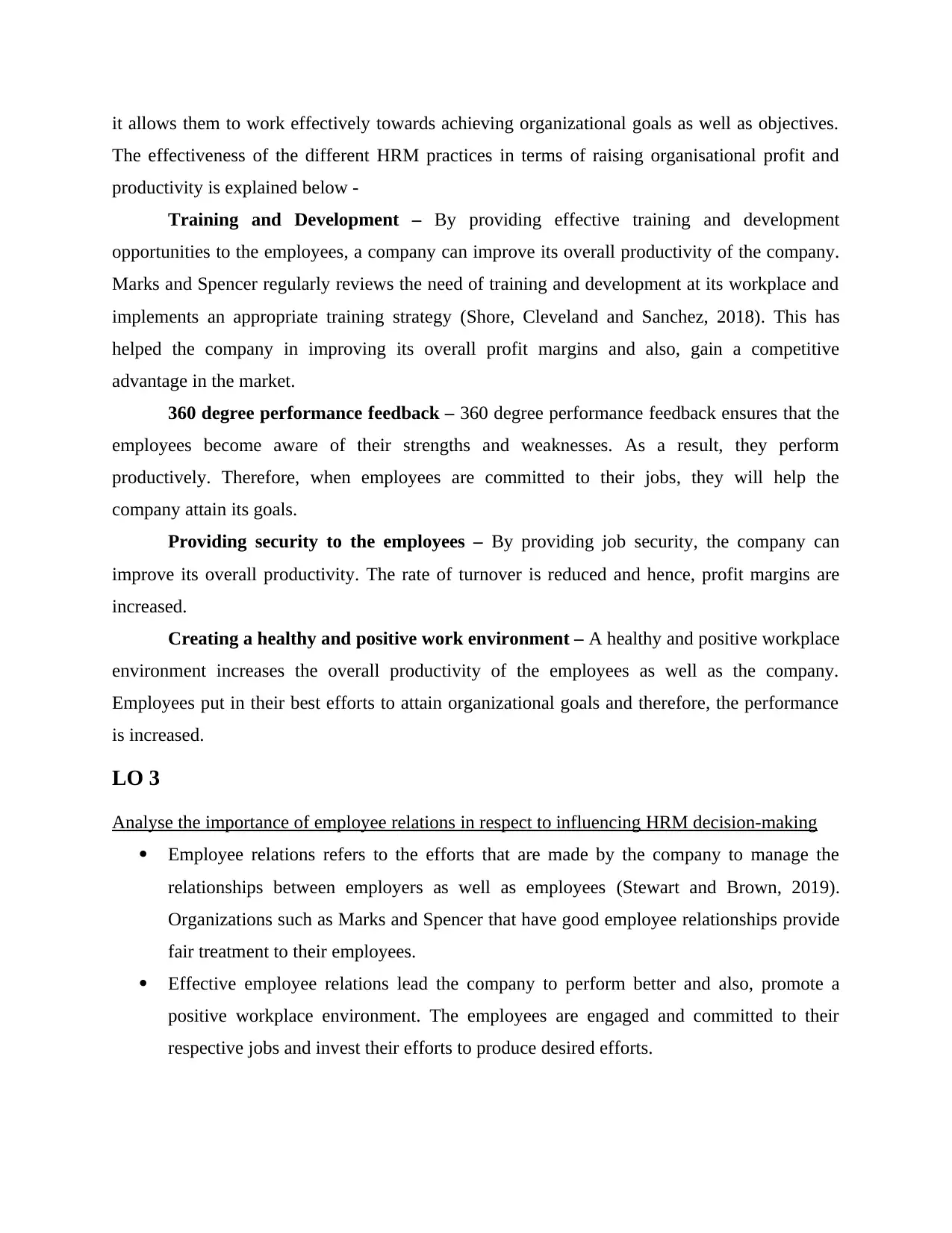
it allows them to work effectively towards achieving organizational goals as well as objectives.
The effectiveness of the different HRM practices in terms of raising organisational profit and
productivity is explained below -
Training and Development – By providing effective training and development
opportunities to the employees, a company can improve its overall productivity of the company.
Marks and Spencer regularly reviews the need of training and development at its workplace and
implements an appropriate training strategy (Shore, Cleveland and Sanchez, 2018). This has
helped the company in improving its overall profit margins and also, gain a competitive
advantage in the market.
360 degree performance feedback – 360 degree performance feedback ensures that the
employees become aware of their strengths and weaknesses. As a result, they perform
productively. Therefore, when employees are committed to their jobs, they will help the
company attain its goals.
Providing security to the employees – By providing job security, the company can
improve its overall productivity. The rate of turnover is reduced and hence, profit margins are
increased.
Creating a healthy and positive work environment – A healthy and positive workplace
environment increases the overall productivity of the employees as well as the company.
Employees put in their best efforts to attain organizational goals and therefore, the performance
is increased.
LO 3
Analyse the importance of employee relations in respect to influencing HRM decision-making
Employee relations refers to the efforts that are made by the company to manage the
relationships between employers as well as employees (Stewart and Brown, 2019).
Organizations such as Marks and Spencer that have good employee relationships provide
fair treatment to their employees.
Effective employee relations lead the company to perform better and also, promote a
positive workplace environment. The employees are engaged and committed to their
respective jobs and invest their efforts to produce desired efforts.
The effectiveness of the different HRM practices in terms of raising organisational profit and
productivity is explained below -
Training and Development – By providing effective training and development
opportunities to the employees, a company can improve its overall productivity of the company.
Marks and Spencer regularly reviews the need of training and development at its workplace and
implements an appropriate training strategy (Shore, Cleveland and Sanchez, 2018). This has
helped the company in improving its overall profit margins and also, gain a competitive
advantage in the market.
360 degree performance feedback – 360 degree performance feedback ensures that the
employees become aware of their strengths and weaknesses. As a result, they perform
productively. Therefore, when employees are committed to their jobs, they will help the
company attain its goals.
Providing security to the employees – By providing job security, the company can
improve its overall productivity. The rate of turnover is reduced and hence, profit margins are
increased.
Creating a healthy and positive work environment – A healthy and positive workplace
environment increases the overall productivity of the employees as well as the company.
Employees put in their best efforts to attain organizational goals and therefore, the performance
is increased.
LO 3
Analyse the importance of employee relations in respect to influencing HRM decision-making
Employee relations refers to the efforts that are made by the company to manage the
relationships between employers as well as employees (Stewart and Brown, 2019).
Organizations such as Marks and Spencer that have good employee relationships provide
fair treatment to their employees.
Effective employee relations lead the company to perform better and also, promote a
positive workplace environment. The employees are engaged and committed to their
respective jobs and invest their efforts to produce desired efforts.
⊘ This is a preview!⊘
Do you want full access?
Subscribe today to unlock all pages.

Trusted by 1+ million students worldwide
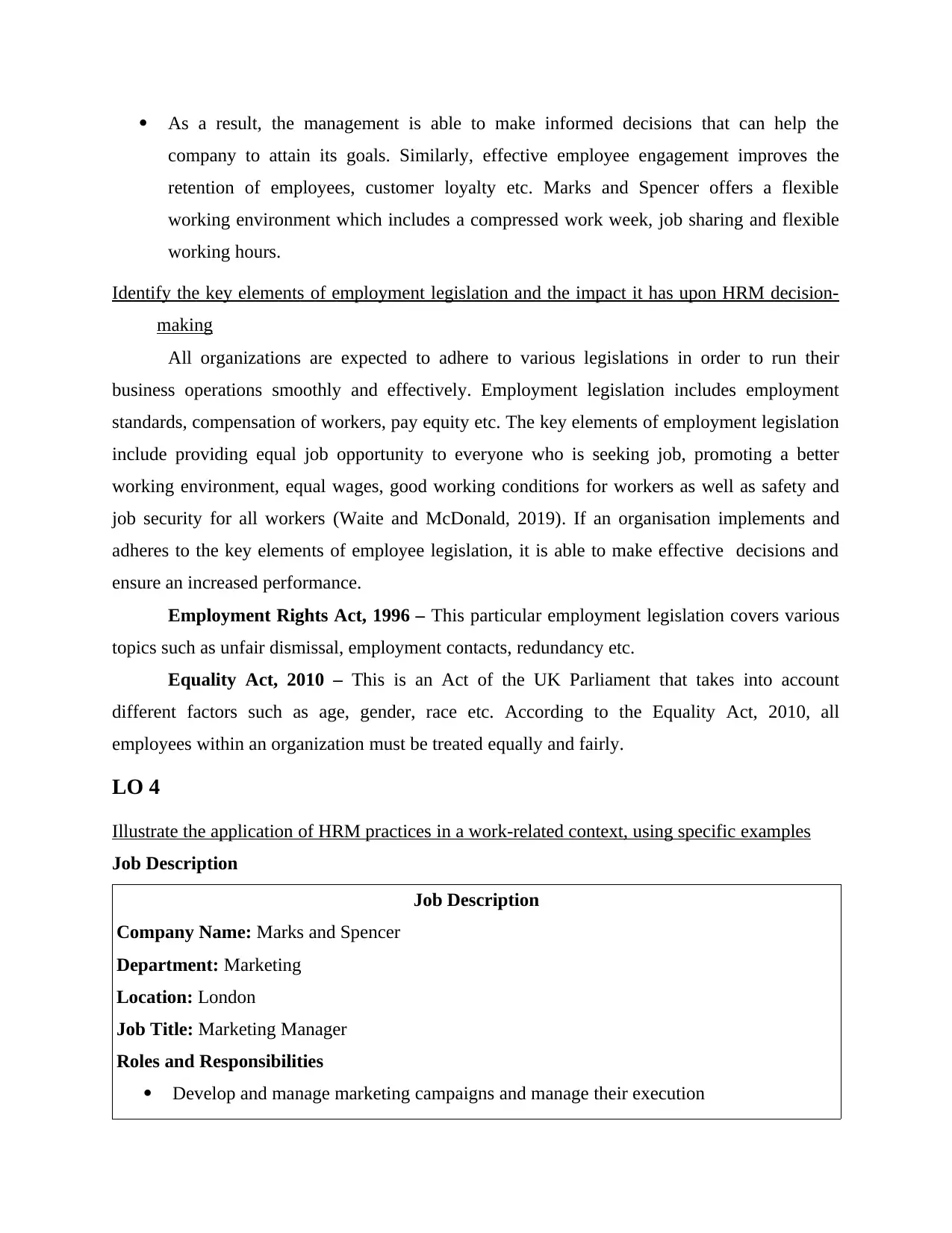
As a result, the management is able to make informed decisions that can help the
company to attain its goals. Similarly, effective employee engagement improves the
retention of employees, customer loyalty etc. Marks and Spencer offers a flexible
working environment which includes a compressed work week, job sharing and flexible
working hours.
Identify the key elements of employment legislation and the impact it has upon HRM decision-
making
All organizations are expected to adhere to various legislations in order to run their
business operations smoothly and effectively. Employment legislation includes employment
standards, compensation of workers, pay equity etc. The key elements of employment legislation
include providing equal job opportunity to everyone who is seeking job, promoting a better
working environment, equal wages, good working conditions for workers as well as safety and
job security for all workers (Waite and McDonald, 2019). If an organisation implements and
adheres to the key elements of employee legislation, it is able to make effective decisions and
ensure an increased performance.
Employment Rights Act, 1996 – This particular employment legislation covers various
topics such as unfair dismissal, employment contacts, redundancy etc.
Equality Act, 2010 – This is an Act of the UK Parliament that takes into account
different factors such as age, gender, race etc. According to the Equality Act, 2010, all
employees within an organization must be treated equally and fairly.
LO 4
Illustrate the application of HRM practices in a work-related context, using specific examples
Job Description
Job Description
Company Name: Marks and Spencer
Department: Marketing
Location: London
Job Title: Marketing Manager
Roles and Responsibilities
Develop and manage marketing campaigns and manage their execution
company to attain its goals. Similarly, effective employee engagement improves the
retention of employees, customer loyalty etc. Marks and Spencer offers a flexible
working environment which includes a compressed work week, job sharing and flexible
working hours.
Identify the key elements of employment legislation and the impact it has upon HRM decision-
making
All organizations are expected to adhere to various legislations in order to run their
business operations smoothly and effectively. Employment legislation includes employment
standards, compensation of workers, pay equity etc. The key elements of employment legislation
include providing equal job opportunity to everyone who is seeking job, promoting a better
working environment, equal wages, good working conditions for workers as well as safety and
job security for all workers (Waite and McDonald, 2019). If an organisation implements and
adheres to the key elements of employee legislation, it is able to make effective decisions and
ensure an increased performance.
Employment Rights Act, 1996 – This particular employment legislation covers various
topics such as unfair dismissal, employment contacts, redundancy etc.
Equality Act, 2010 – This is an Act of the UK Parliament that takes into account
different factors such as age, gender, race etc. According to the Equality Act, 2010, all
employees within an organization must be treated equally and fairly.
LO 4
Illustrate the application of HRM practices in a work-related context, using specific examples
Job Description
Job Description
Company Name: Marks and Spencer
Department: Marketing
Location: London
Job Title: Marketing Manager
Roles and Responsibilities
Develop and manage marketing campaigns and manage their execution
Paraphrase This Document
Need a fresh take? Get an instant paraphrase of this document with our AI Paraphraser
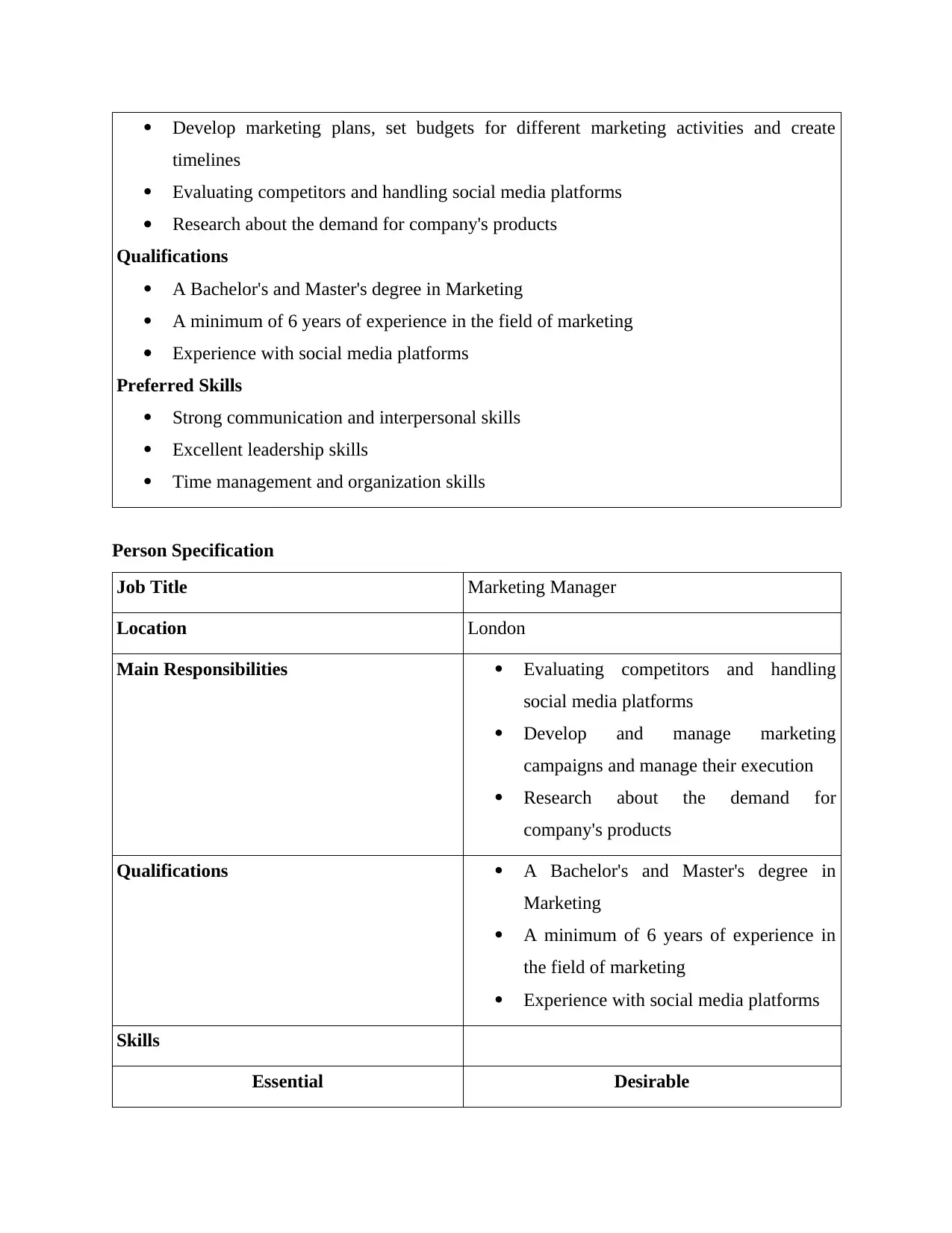
Develop marketing plans, set budgets for different marketing activities and create
timelines
Evaluating competitors and handling social media platforms
Research about the demand for company's products
Qualifications
A Bachelor's and Master's degree in Marketing
A minimum of 6 years of experience in the field of marketing
Experience with social media platforms
Preferred Skills
Strong communication and interpersonal skills
Excellent leadership skills
Time management and organization skills
Person Specification
Job Title Marketing Manager
Location London
Main Responsibilities Evaluating competitors and handling
social media platforms
Develop and manage marketing
campaigns and manage their execution
Research about the demand for
company's products
Qualifications A Bachelor's and Master's degree in
Marketing
A minimum of 6 years of experience in
the field of marketing
Experience with social media platforms
Skills
Essential Desirable
timelines
Evaluating competitors and handling social media platforms
Research about the demand for company's products
Qualifications
A Bachelor's and Master's degree in Marketing
A minimum of 6 years of experience in the field of marketing
Experience with social media platforms
Preferred Skills
Strong communication and interpersonal skills
Excellent leadership skills
Time management and organization skills
Person Specification
Job Title Marketing Manager
Location London
Main Responsibilities Evaluating competitors and handling
social media platforms
Develop and manage marketing
campaigns and manage their execution
Research about the demand for
company's products
Qualifications A Bachelor's and Master's degree in
Marketing
A minimum of 6 years of experience in
the field of marketing
Experience with social media platforms
Skills
Essential Desirable
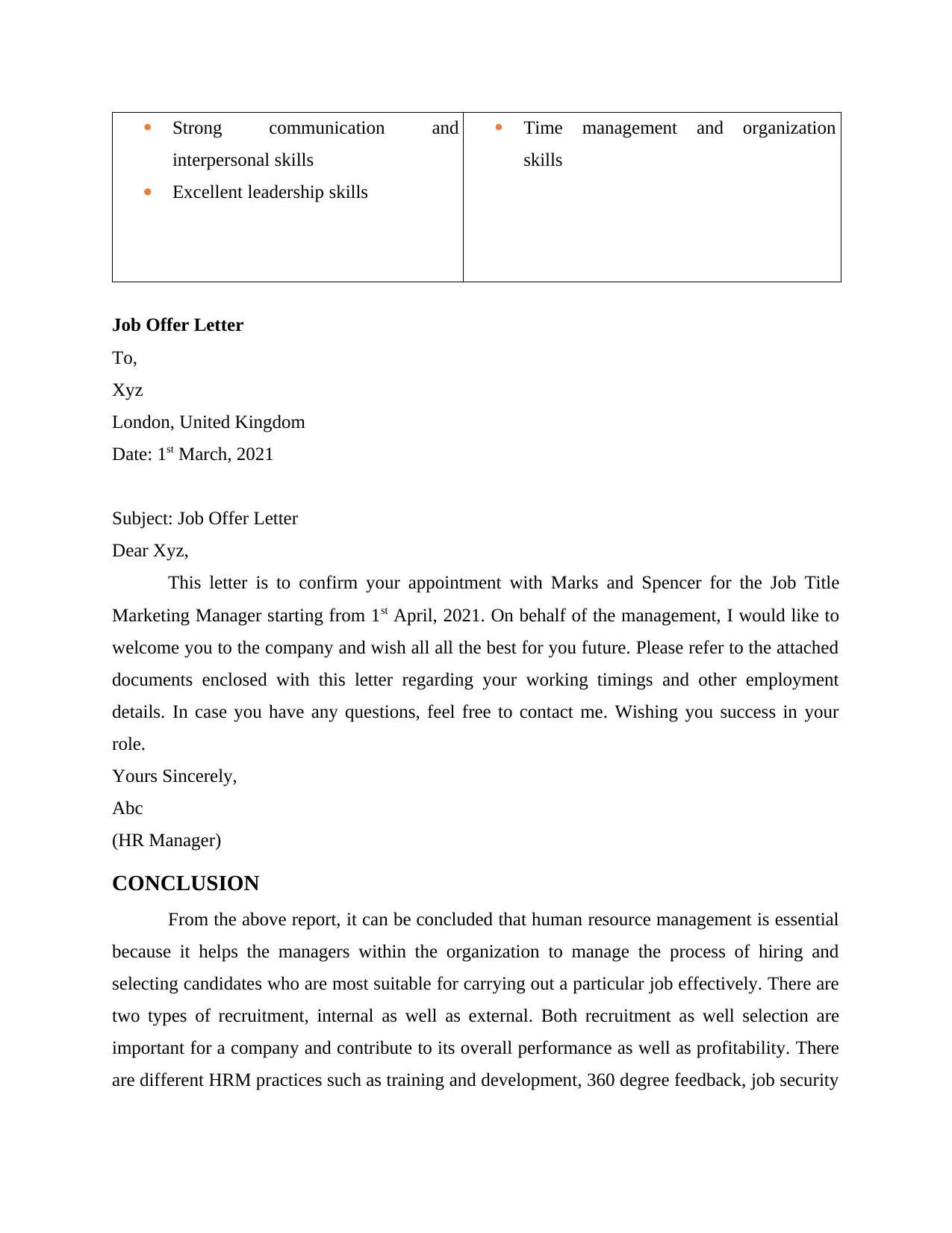
Strong communication and
interpersonal skills
Excellent leadership skills
Time management and organization
skills
Job Offer Letter
To,
Xyz
London, United Kingdom
Date: 1st March, 2021
Subject: Job Offer Letter
Dear Xyz,
This letter is to confirm your appointment with Marks and Spencer for the Job Title
Marketing Manager starting from 1st April, 2021. On behalf of the management, I would like to
welcome you to the company and wish all all the best for you future. Please refer to the attached
documents enclosed with this letter regarding your working timings and other employment
details. In case you have any questions, feel free to contact me. Wishing you success in your
role.
Yours Sincerely,
Abc
(HR Manager)
CONCLUSION
From the above report, it can be concluded that human resource management is essential
because it helps the managers within the organization to manage the process of hiring and
selecting candidates who are most suitable for carrying out a particular job effectively. There are
two types of recruitment, internal as well as external. Both recruitment as well selection are
important for a company and contribute to its overall performance as well as profitability. There
are different HRM practices such as training and development, 360 degree feedback, job security
interpersonal skills
Excellent leadership skills
Time management and organization
skills
Job Offer Letter
To,
Xyz
London, United Kingdom
Date: 1st March, 2021
Subject: Job Offer Letter
Dear Xyz,
This letter is to confirm your appointment with Marks and Spencer for the Job Title
Marketing Manager starting from 1st April, 2021. On behalf of the management, I would like to
welcome you to the company and wish all all the best for you future. Please refer to the attached
documents enclosed with this letter regarding your working timings and other employment
details. In case you have any questions, feel free to contact me. Wishing you success in your
role.
Yours Sincerely,
Abc
(HR Manager)
CONCLUSION
From the above report, it can be concluded that human resource management is essential
because it helps the managers within the organization to manage the process of hiring and
selecting candidates who are most suitable for carrying out a particular job effectively. There are
two types of recruitment, internal as well as external. Both recruitment as well selection are
important for a company and contribute to its overall performance as well as profitability. There
are different HRM practices such as training and development, 360 degree feedback, job security
⊘ This is a preview!⊘
Do you want full access?
Subscribe today to unlock all pages.

Trusted by 1+ million students worldwide
1 out of 14
Related Documents
Your All-in-One AI-Powered Toolkit for Academic Success.
+13062052269
info@desklib.com
Available 24*7 on WhatsApp / Email
![[object Object]](/_next/static/media/star-bottom.7253800d.svg)
Unlock your academic potential
Copyright © 2020–2025 A2Z Services. All Rights Reserved. Developed and managed by ZUCOL.





